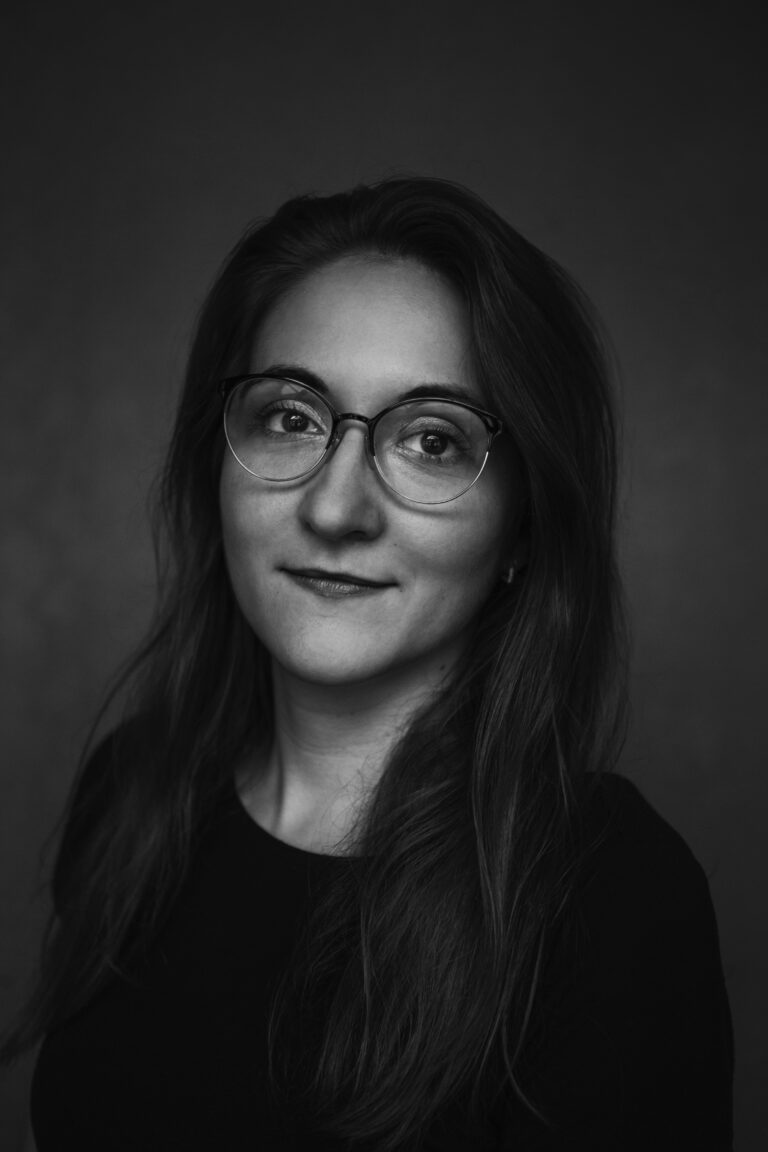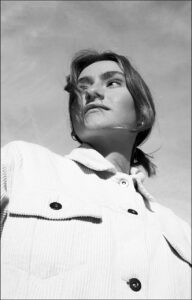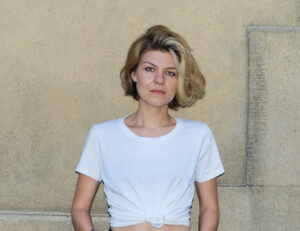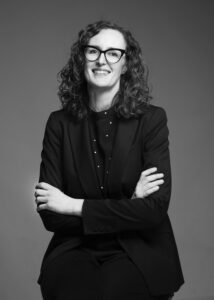Miroslava Ptáčková

– (née Kupčíková) born 1990 – glass artist, sculptor, curator and producer. She graduated from the Secondary School of Applied Arts in Uherské Hradiště, majoring in Stone Sculpture (2005-2009). Subsequently, she continued her studies at the Tomas Bata University in Zlín (2009-2014) at the Department of Glass Design. She has been working on her doctoral dissertation in the same studio since 2015. She is currently the head of the Václav Chad Gallery in Zlín and the founder of the Zlín Design Market project. She actively participates in solo and group exhibitions throughout the Czech Republic and abroad. She is living and working in Zlín.
I have been interested in art since I was a child. Even though no one in my family is making art professionally, they have always supported me in my work. I gravitated towards the techniques of modelling so I decided to study Stone Sculpture at the Secondary School of Applied Arts in Uherské Hradiště. Under the leadership of the academic sculptors Jiří Habarta, Milan Kusenda and Zdeněk Tománek, I gained valuable experience and received much useful advice. Even though it is a predominantly male field, I studied and learned sculptural techniques, while working with various materials, both traditional and new. It has always been important for me to work not only with the aforementioned materials but also with volume, space and light. I had the opportunity to develop this further in the Studio of Glass Design under the leadership of prof. MgA. Petr Stanický, M.F.A.
Artistic practice is a process that is constantly evolving and changing. I try to find enough time for my practice but sometimes it is quite difficult to put everything together. Every day I am moving through a gallery environment — I am in the position of a gallery manager. Through my job, I meet many artists, curators, collectors and other interesting personalities. I can use the experience that I have gained through the curatorship of exhibitions and implement it when working on my own exhibition projects. My husband Zdeněk helps me with the installations of individual pieces and even with entire exhibition projects. He is very interested in art, even though he does not have any professional background in art. Apart from my job, I am a doctoral student in the field of contemporary tendencies of Czech glass in fine arts over the last decade — see the publication Glass in the Lead Role 1.
My relationship with politics is neutral. I do follow the events around me, but rather from a more global perspective of the world, so I do not deal with specific topics in a structured manner. I do not consider political issues influential in my work so far. This is probably due to the fact that I grew up in a democratic society. Although in a young democracy — where everyone is looking for their direction, purpose but also their boundaries. I consider freedom of artistic expression to be of great importance. I am grateful for the opportunity to create the way I feel. It is also given by the environment in which the artist grew up and the people who surrounded them.
Since the beginning of my artistic practice, I have been trying to find new possibilities, connections and ways of handling materials through interconnection and mutual influence — whether with fragile glass, flexible rubber inner tube, structured fibreglass, etc. I assemble individual objects in space in a symbiosis of these different forms that communicate with each other. At the same time, I attempt to break the stereotype of our perception. The first significant work of mine was the series of objects Breath of the Inner Tube (2014). The aspiring air bubbles from the valve led me to the idea of working with the volume inside the inner tube itself. The experiments took place directly at the glassworks. During the process, the air was being forced out of the inner tube directly into the glass whistle and into the transforming melted glass. On the other hand, in Pneuma I-V (2014-2018), I dealt with the process of internal stress and the boundaries of mutual relations. The objects were created by compressing the inner tube between the glass surfaces. Pressure accumulated on the inside while simultaneously external pressure was being applied through the means of tubes, stretched over the glass surfaces. It is possible to observe the process of deformation, but also the purity of the shape, mutual balancing of forces and equilibrium in a new spatial connection.For the last year, I have been working with sheets of glass and fibreglass — layering, etching, sanding and finishing the surfaces of nets with a body of synthetic paints. “What arises is a seemingly unexpected image of a landscape, or more precisely a mirror of nature (…). The order of the natural world and the corresponding order of the artistic expression of the lines is fundamental and decisive. We find familiar forms of the rhythms of nature in its division and separation. But all this happens with a view from the other side, emerging from the properties of the material. Form preceded content so that it itself became content and merged with it into a singularity. To be nature, tree, water, horizon, flower, mountain, the way of glass born. By layering perforated fibre nets and crossing the directions of its warp, it changes the density of the tissue, tunes the amount of transmitted light and bends it in space (Effervescence of Water, 2020). Light plays a major role here. It accompanies the glass landscape with small drawings, as if with a brush and ink on handmade paper, and significantly complements the briefly market objects. It clearly shows that even such different paths have the same aim and in the order of the world, in spite of time, in its primordial essence and harmonious unity, they meet each other”2.
Written by Miroslava Ptáčková (2021).
1Miroslava Ptáčková, Glass in the lead role, Zlín: Tomas Bata University in Zlín, 2020.2Miroslav Koval, In the landscape of light. Sumperk: Jiří Jílek Gallery, 2020, p.4-5.
(roz. Kupčíková) – narozena 1990 – sklářská výtvarnice, sochařka, kurátorka a produkční. Miroslava Ptáčková vystudovala Střední uměleckoprůmyslovou školu Uherské Hradiště, obor Kamenosochařství-kamenosochařská tvorba (2005-2009). Následně pokračovala ve studiu na Univerzitě Tomáše Bati ve Zlíně (2009-2014) v Ateliéru Design skla. Zde se distančně věnuje doktorskému studiu (od 2015). V současné době je vedoucí Galerie Václava Chada ve Zlíně a zakladatelkou projektu Zlín Design Market. Aktivně se účastní samostatných i skupinových výstav v Česku i zahraničí. Nyní žije a pracuje ve Zlíně.
O umění jsem se zajímala již od dětství. I když se v rodině profesionálně umění nikdo nevěnuje, vždy mě v tvorbě podporovali. Nejblíže jsem měla k modelování. Proto jsem se rozhodla vystudovat Kamenosochařství na UMPRUM v Uherském Hradišti. Pod vedením ak. soch. Jiřího Habarty, ak. soch. Milana Kusendy a ak. soch. Zdeňka Tománka jsem získala cenné rady a zkušenosti. V převážně mužském oboru jsem se naučila sochařské technice, práci s různými materiály, ať už klasickými nebo novými. Vždy pro mě byla důležitá práce s již zmíněnými materiály, ale také s objemem, prostorem, světlem. To jsem měla příležitost rozvíjet i v Ateliéru Design skla pod vedením prof. MgA. Petra Stanického, M.F.A.
Umělecká tvorba je proces, který se neustále vyvíjí a proměňuje. Snažím se pro tvorbu najít dostatek času, někdy je ovšem poměrně náročné vše skloubit. Denně se pohybuji v galerijním prostředí – jsem na pozici vedoucí galerie. Prostřednictvím mého zaměstnání tak potkávám spoustu umělců, kurátorů, sběratelů a dalších zajímavých osobností. Získané zkušenosti s výstavnictvím tak mohu využít i při realizaci vlastních výstavních projektů. S vlastními instalacemi jednotlivých děl i celých výstavních projektů mi pomáhá manžel Zdeněk. Praxí není z uměleckého okruhu, ale o umění se velmi zajímá. Vedle zaměstnání se distančně věnuji doktorskému studiu v oblasti aktuálních tendencí českého skla ve volném umění za posledních deset let – viz publikace Sklo v hlavní roli1.
Můj vztah k politice je neutrální. Dění kolem samozřejmě sleduji, ale spíše z celkového pohledu na svět, než abych se cíleně zabývala přesnými tématy. Politické otázky nepovažuji za směrodatné v mé dosavadní tvorbě. Je to dáno zřejmě i tím, že jsem vyrůstala v demokratické společnosti. I když v mladé demokracii – kde si každý hledá svůj směr, uplatnění ale i mantinely. Za důležitou považuji svobodu se výtvarně projevit. Jsem vděčná za možnost tvořit tak, jak to cítím já. Je to dáno i prostředím, kde umělec vyrůstá a lidmi, kteří jej obklopují.
Od počátku tvorby se snažím nalézat nové možnosti, vazby i způsoby zacházení s materiály jejich propojováním a ovlivňováním – ať už to s křehkým sklem, pružnou pryžovou duší, strukturovaným sklovláknem aj. U jednotlivých objektů v prostoru pracuji se symbiózou těchto odlišných forem, které spolu komunikují. Zároveň usiluji o narušení stereotypu našeho vnímání. Prvním výraznějším dílem se stal cyklus objektů Dech duše (2014). Ucházející vzduchové bublinky z nasliněného ventilku mě přivedly k myšlence pracovat s objemem uvnitř samotné duše. Experimenty probíhaly přímo na sklářské huti. Během procesu byl vytlačován vzduch z duše přímo do sklářské píšťaly a do skloviny, která se proměňovala. Naopak u Pneuma I-V (2014-2018) jsem se zabývala procesem vnitřního napětí a hranicí vzájemných vztahů. Objekty vznikaly stlačením duše mezi skleněnými plochami, kde působilo vnitřní pnutí a zároveň nastalo vnější pnutí pomocí napjatých duší přes plochy skel. Je možné pozorovat proces deformace, ale i čistotu tvaru, vzájemné vyrovnání sil a rovnováhy v nové prostorové vazbě.
Poslední rok pracuji s tabulovým sklem a sklovláknem – vrstvení, leptání, broušení a dotváření povrchu sítí hmotou syntetických barev. „Co vzniká, je zdánlivě nečekaným obrazem krajiny nebo přesněji zrcadlem přírody (…). Řád přirozeného světa a jemu odpovídající řád výtvarné výpovědi linií je zásadní a určující. Nalézáme důvěrně známé podoby rytmů přírody v jejím členění. Všechno to děje se ale „pohledem z druhého břehu“, noří se z vlastností materiálu. Forma předešla obsah, aby se sama stala obsahem a splynula s ním v jediném. Aby byla přírodou, stromem, vodou, horizontem, květem, horou, cestou ze skla zrozenou. Vrstvením sítí z děrované vlákniny a křížením směrů její osnovy mění hustotu tkáně, ladí míru prostupujícího světla a ohýbáním nechává vyjít i do prostoru (např. Šumění vody, 2020). Světlo tu hraje hlavní roli. Drobnými kresbami štětcem a tuší na ručním papíře skleněné krajiny doprovází a v letmém záznamu objekty významně doplňuje. Zřetelně ukazuje, že i tak různé cesty vedou ke stejnému cíli a v řádu světa, v jeho prapodstatě a harmonické jednotě, se navzdory času spolu potkávají“2.
Napsala Miroslava Ptáčková (2021).
1Miroslava Ptáčková, Sklo v hlavní roli. Zlín: Univerzita Tomáše Bati ve Zlíně, 2020.2Miroslav Koval, V krajině světla. Šumperk: Galerie Jiřího Jílka, 2020, s. 4-5.


